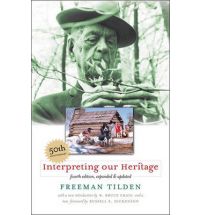 This summer we are completely overhauling our brick-and-mortar historical museum. When we reopen after Thanksgiving we will have three new and three dramatically reimagined permanent exhibits. As the educator, my job is to develop resources and interpretive manuals on all the new exhibits. This also means developing a new training program to get the docents and guides up to speed. Working with docents is a relatively new experience for me. So, in having to develop a new training program and interpretive materials from scratch, I decided the best thing to do was get some help. I found some great resources, which I’d like to share with you.
This summer we are completely overhauling our brick-and-mortar historical museum. When we reopen after Thanksgiving we will have three new and three dramatically reimagined permanent exhibits. As the educator, my job is to develop resources and interpretive manuals on all the new exhibits. This also means developing a new training program to get the docents and guides up to speed. Working with docents is a relatively new experience for me. So, in having to develop a new training program and interpretive materials from scratch, I decided the best thing to do was get some help. I found some great resources, which I’d like to share with you.
- Interpreting Our Heritage by Freeman Tilden. Yes, I know: DUH, of course this is a key work! I read it in graduate school, but have recently been encouraging my docents to read it as well. I bought several copies for a new volunteer lending library we created, and I am finding the docents and I appreciate the philosophy behind it. Many have altered the way they give tours based on Tilden’s advice.
- Great Tours!: Thematic Tours and Guide Training for Historic Sites by Barbara Abramoff Levy, Sandra Mackenzie Lloyd, and Susan Porter Schreiber. This is an excellent soup-to-nuts guide for training docents who interpret historical house museums. However, I have found that it has great training exercises and games that can be adapted for traditional museums and exhibits.
- The Museum Educator’s Manual: Educators Share Successful Techniques by Anna Johnson, Kimberly A. Huber, Nancy Cutler, Melissa Bingmann, and Tim Grove. I love this book! The first part, titled “Training and Management” has been a lifesaver. Chapters three and four provide a practical step-by-step guide for creating a docent training program and fantastic tours. Plus, it has great sidebars with fun training games and activities.
 There are countless other resources as well, most of which I have found with good old-fashioned benchmarking. In true Arrrrducation Pirate style, I looked at what other museums are doing and “borrowed” some great ideas. (Thank you, Lower East Side Tenement Museum for your wonderful interpreter manual!)
There are countless other resources as well, most of which I have found with good old-fashioned benchmarking. In true Arrrrducation Pirate style, I looked at what other museums are doing and “borrowed” some great ideas. (Thank you, Lower East Side Tenement Museum for your wonderful interpreter manual!)
Lastly, I decided that I wasn’t going to write these new interpretation materials alone. I have set up brainstorming sessions this August for any docent who would like to come. We will talk through the learning goals of the exhibits, go over a lot of historical content, and make decisions as a group on how it can best be interpreted to the public. I told you last week, my docents have some darn good ideas. I will let you know how it all turns out this fall. In the meantime, if you have any good tips for creating interpretive manuals or working with docents, please share!



